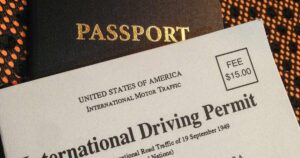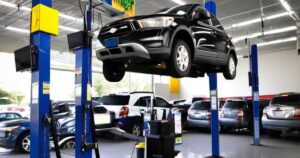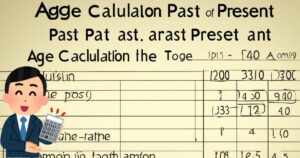In this comprehensive guide, we’ll delve into the best and worst Subaru Outback years. Our analysis is data-driven, combining real-world owner experiences, industry ratings, and maintenance trends. Explore how technological advancements and design tweaks have influenced performance and perception over time. Gain the knowledge necessary to make an informed decision when purchasing a pre-owned Subaru Outback.
- Highlight the standout models and identify potential pitfalls.
- Draw from an extensive research base.
- Offer an unparalleled overview of the Outback’s storied lineage.
- Empower you with the knowledge necessary for purchasing a pre-owned Subaru Outback.
- Pay close attention to:
- Generational differences
- Technological advancements
- Design tweaks
- Impact on performance and perception
Subaru Outback Generations Explained
The Subaru Outback, a unique blend of sedan comfort and SUV capabilities, started its journey in the automotive industry with its first-generation models. While the first generation introduced the world to the Outback’s potential, here we will be focusing on the Outback models starting from the year 2000:
| Generation | Years |
| 2nd generation (BH) | 2000-2004 |
| 3rd generation (BP) | 2005-2009 |
| 4th generation (BR) | 2010-2014 |
| 5th generation (BS) | 2015-2019 |
| 6th generation (BT) | 2020-2024 |
Understanding these generations is crucial when making purchasing decisions, as substantial changes between them can greatly impact reliability, performance, and overall ownership experience, especially considering the Outback’s evolution over the years.
Evaluating the Best, Neutral, and Worst Subaru Outback Years
Determining the best and worst years for a car model involves an in-depth analysis of a vast array of data sources, ensuring a comprehensive assessment. Some of the critical factors we consider in our rankings include:
- Owner-reported reliability (surveys)
- Annual maintenance costs
- Safety ratings
- Consumer Reports reliability scores
- Consumer Reports owner satisfaction scores
- NHTSA recalls, investigations, and complaints
- Edmunds owner ratings
- JD Power owner ratings
- Kelley’s Blue Book (KBB) owner ratings
- VehicleHistory owner ratings
- Cars.com owner ratings
The collective insights from these various ratings provide a holistic view of the Subaru Outback’s performance over the years, as illustrated in the graph below.
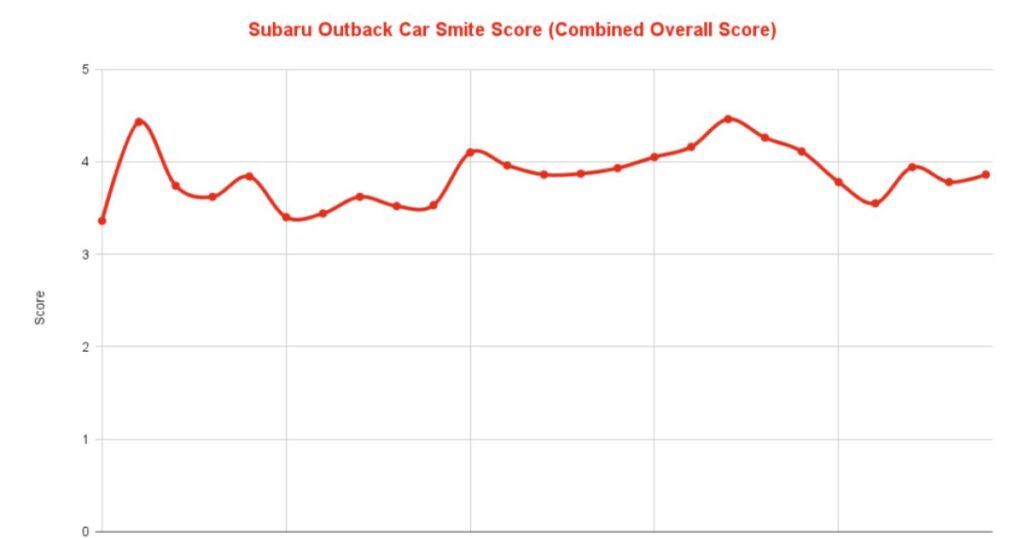
In the table below, we have categorized all Subaru Outback model years into the best, neutral, and worst years based on our analysis.
| Generation | Best Years | Neutral Years | Worst Years |
| 2nd generation (BH) | 2001 | 2002 | 2000, 2003, 2004 |
| 3rd generation (BP) | 2007 | 2006 | 2005, 2008, 2009 |
| 4th generation (BR) | 2014 | 2013 | 2010, 2011, 2012 |
| 5th generation (BS) | 2016, 2017 | 2018, 2019 | 2015 |
| 6th generation (BT) | 2022, 2024 | 2023 | 2020, 2021 |
When we mention “Neutral Years,” we are referring to model years that neither excel in reliability nor fall short significantly. They represent an average performance, without any major highs or lows.
It’s also worth noting that while many of these factors contribute positively to a car’s standing, there are some, like NHTSA recalls, which detract from its score. A higher count of complaints and recalls equates to a decline in a car’s reliability, leading to a reduced score in our rankings.
Let’s explore the specifics of the best, neutral, and worst years for the Toyota RAV4 in more detail.
Best & Worst Years: Subaru Outback 2nd Generation (2000-2004)
Subaru’s Outback entered its second generation from 2000 to 2004, featuring notable improvements in design and mechanics. This period marked a definitive evolution of the brand, further cementing its reputation in the market.
The Best Year: 2001
The 2001 model year remains one of the strongest performers within the second generation. Boasting improved engine performance and refined design, the car successfully catered to a growing market of SUV lovers.
Safety features were enhanced, and Subaru made strides in implementing better technology within the car. Notably, the car had minor engine problems. Owners reported that it could leak fuel during the cold winter season. Similarly, there were occasional reports that the service brakes might not function optimally in colder conditions.
The Neutral Year: 2002
The 2002 Subaru Outback, while not achieving the heights of its predecessor, still maintained a good track record in reliability and performance.
With many of the technological and safety features of the 2001 model carrying over, it offered consistent drivability and safety. However, it was not immune to the minor engine and brake issues seen in the 2001 model, with a few owners reporting similar fuel leak problems during cold weather.
The Worst Years: 2000, 2003, 2004
The beginning of the second era, the 2000 version, encountered some major problems. Specifically, it experienced a problem akin to Ford as a result of Firestone brand tires.
Owners reported that the tire treads could separate unexpectedly, leading to potential mishaps at high speeds. Transmission issues such as slips, and complete failures as well as engine issues like head gasket failures were not uncommon.
The 2003 Subaru Outback faced multiple recalls. One pressing issue was the potential for the airbag inflator to explode, posing a grave safety risk. Subaru recognized the severity of the problem and initiated a recall in 2016 for both 2003–2004 and 2009–2011 Outback models, impacting up to 302,127 vehicles.
The 2004 model also introduced a fresh issue concerning vehicle control. Owners lodged complaints that the accelerator pedal would sometimes become unresponsive.
Best & Worst Years: Subaru Outback 3rd Generation (2005-2009)
The 3rd Generation Subaru Outback, spanning from 2005 to 2009, witnessed a blend of innovative designs and technological advancements, solidifying Subaru’s reputation in the auto industry.
Introduced with enhanced safety features, spacious interiors, and versatile engine options, this generation was crafted to cater to varied customer needs.
The Best Year: 2007
The 2007 Subaru Outback was a testament to Subaru’s commitment to innovation. This model was designed with the symmetrical AWD system, ensuring the vehicle remained stable across diverse terrains.
Depending on the variant, customers had the choice between a dynamic 2.5L flat-4 engine or a more powerful 3.0L flat-6 engine. Safety was at the forefront, with the introduction of features like Electronic Brake-force Distribution (EBD) and Brake Assist.
The infotainment system received a facelift, providing passengers with an enriched entertainment experience. The interiors, especially in the premium trims, were draped in plush leather upholstery, adding a touch of luxury.
The Neutral Year: 2006
The 2006 model built on the foundation laid by its predecessor. Subaru addressed the ongoing airbag issues, striving for enhanced vehicle safety.
The car came equipped with the Vehicle Dynamics Control (VDC), which used sensors to gauge steering and braking inputs, ensuring optimal vehicle stability. However, it wasn’t without its share of challenges.
Notably, according to the NHTSA, there were reports of the gas pedal loosening, resulting in power lapses or unplanned acceleration.
The Worst Years: 2005, 2008, 2009
The 2005 model year, though promising on paper, faced challenges on the ground. Its elevated ground clearance and optional turbocharged engine made it appealing to many. However, suspension issues emerged as a persistent challenge.
Owners frequently reported that the vehicle swerved unpredictably in wet conditions. Further compounding the issues, brake line corrosion emerged as a problem, causing potential brake fluid leaks and consequent reduction in braking efficiency.
A significant recall in 2014 that included the 2005–2009 Outback models underscored these issues.
For the 2008 and 2009 models, Subaru aimed to rectify past mistakes. Although not as problematic as the 2005 edition, they did carry forward some of the earlier concerns, requiring attention and potential recall interventions.
Best & Worst Years: Subaru Outback 4th Generation (2010-2014)
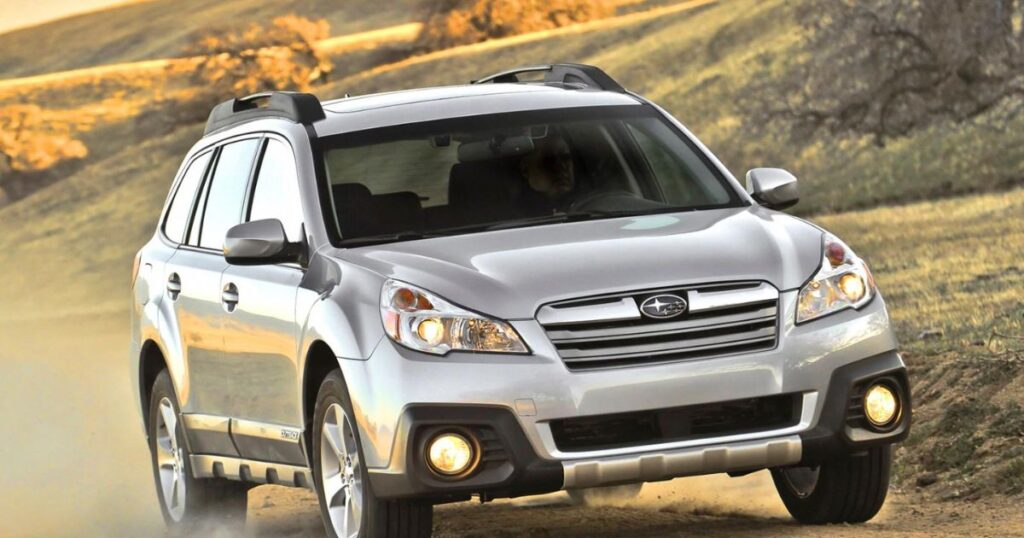
The 4th generation Subaru Outback, spanning from 2010 to 2014, represented a significant leap in both design and technology. With a focus on fuel efficiency, safety, and comfort, Subaru looked to cater to an audience that valued both performance and practicality.
The Best Year: 2014
The 2014 Subaru Outback was the pinnacle of the fourth generation in terms of overall performance and reliability. Featuring enhanced safety systems, this model year saw the introduction of the EyeSight Driver Assist Technology, which included adaptive cruise control, pre-collision braking, and lane departure warnings.
The infotainment system was also upgraded, offering a more intuitive user experience and better connectivity options. While there were minor complaints about interior design and road noise, the model was generally well-received for its robust engine performance and off-road capability.
The Neutral Year: 2013
The 2013 Subaru Outback served as a bridge between earlier models and the refined 2014 version. Benefitting from many of the technological advancements of the fourth generation, it offered an all-wheel drive as standard and was praised for its spacious interior and cargo space.
Fuel efficiency remained a strong point, and the vehicle’s safety features, including its stability control and comprehensive airbag system, were commendable.
Minor issues included complaints about the continuously variable transmission (CVT) and occasional concerns about dashboard electronics.
The Worst Years: 2010, 2011, 2012
The initial years of the fourth generation faced several challenges that were progressively addressed in subsequent models. The 2010 model year faced persistent problems with the airbag inflator.
Recalls were announced in both 2019 and 2020, addressing this issue specifically for 2010-2014 models. Owners also reported troubling instances where the engine would stall unexpectedly while driving, posing significant safety risks.
This engine stalling problem was not exclusive to the 2010 model and was also characteristic of the 2011 and 2012 models. These two years, while benefiting from the advancements of the fourth generation in terms of design and basic features, struggled with reliability issues.
Consumer feedback often pointed to the CVT, with complaints ranging from noise to complete transmission failure.
Best & Worst Years: Subaru Outback 5th Generation (2015-2019)
The 5th generation Subaru Outback, covering the years from 2015 to 2019, showcased the brand’s commitment to technological innovation and enhanced safety features. Building on the previous generation’s foundation, this series integrated cutting-edge driver-assist technologies and refined its overall driving experience.
The Best Years: 2016, 2017
The 2016 and 2017 Subaru Outbacks were the gems of the fifth generation. These years were marked by a robust suite of safety features, with Subaru’s EyeSight Driver Assist Technology taking center stage, offering drivers adaptive cruise control, lane-keep assist, and pre-collision braking.
In addition to this, the infotainment system underwent further refinements, providing users with a seamless integration of their devices and more intuitive navigation features.
On the mechanical side, the engines were praised for their fuel efficiency and reliability, while the overall build quality of these years was consistently lauded by both critics and owners alike.
The Neutral Years: 2018, 2019
The 2018 and 2019 Subaru Outbacks were marked by evolutionary rather than revolutionary changes. While maintaining the strong safety and technological foundation set by their predecessors, these models introduced slight refinements in comfort and design.
For instance, noise insulation was improved, and minor adjustments were made to the suspension for a smoother ride. However, during this period, Subaru also faced recalls concerning fuel pump failures. It’s worth noting that while these issues were promptly addressed, it caused slight apprehension among potential buyers.
The Worst Year: 2015
The 2015 Subaru Outback, the introductory year of this generation, faced a series of challenges. The most pressing concern was a warning issued by the NHTSA covering specific 2015 and 2016 models.
This recall highlighted a manufacturing defect where the steering column may have been improperly machined, leading to a potential loss of steering ability. Specifically, for Outbacks manufactured between February 29, 2016, and May 6, 2016, it was crucial for potential buyers to check the VIN of the vehicle before purchasing.
Additionally, electrical system issues were a common complaint during this year, leading to sporadic system glitches and inconsistencies in the user experience.
Best & Worst Years: Subaru Outback 6th Generation (2020-2024)
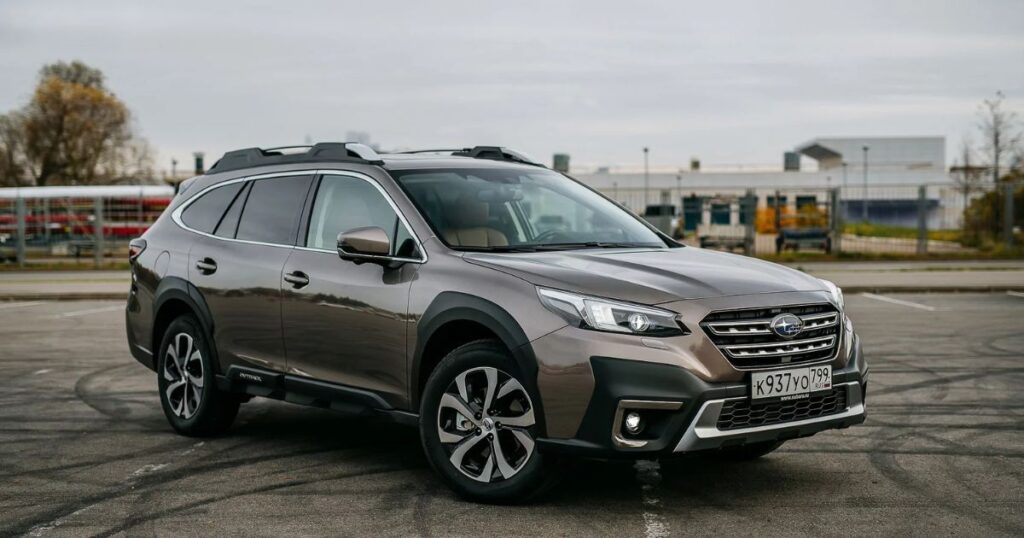
The 6th generation Subaru Outback, spanning from 2020 to 2024, represented a leap forward in Subaru’s engineering and design philosophy. With a revamped platform, the cars of this generation aimed to provide superior comfort, stability, and safety.
The Best Years: 2022, 2024
The 2022 and 2024 Subaru Outbacks can be rightfully deemed as the pinnacle of this generation. These years saw the introduction of Subaru’s most advanced EyeSight X Driver Assist Technology, which utilized a combination of radar, lidar, and high-definition cameras to ensure top-notch safety on the road.
Moreover, the introduction of the new 2.4-liter turbocharged engine option provided an ideal balance of power and fuel efficiency. The interiors received a noticeable upgrade with high-quality materials, and the infotainment system boasted larger touchscreens with faster processing capabilities.
The Neutral Year: 2023
The 2023 model can be categorized as a middle-ground year for the Subaru Outback. While continuing with the technical and safety advancements of its predecessors, this model year focused more on refining existing features rather than introducing radical changes.
The adaptive cruise control system saw minor tweaks to improve its response during traffic conditions, and the infotainment system received software updates for better connectivity and user experience.
The Worst Years: 2020, 2021
Unfortunately, the early years of the sixth generation — 2020 and 2021 — were not without issues. The 2020 model faced substantial criticism due to its windshield and electrical system problems.
Owners frequently reported that the windshields would crack or fracture far too easily, sometimes without any significant impact. The electrical system was also prone to glitches, with many users experiencing intermittent faults with the infotainment system, causing it to either freeze or reboot without warning.
The 2021 model, despite being an iteration forward, continued to experience these problems, dampening its appeal in the market. Moreover, the vehicle’s safety tech, while advanced, occasionally provided false alerts, leading to moments of unnecessary panic or confusion for the drivers.
Subaru Outback Average Resale Values Analyzed
The graph below illustrates the average resale values of the Subaru Outback across various model years, offering insights into its depreciation trends and long-term investment potential.
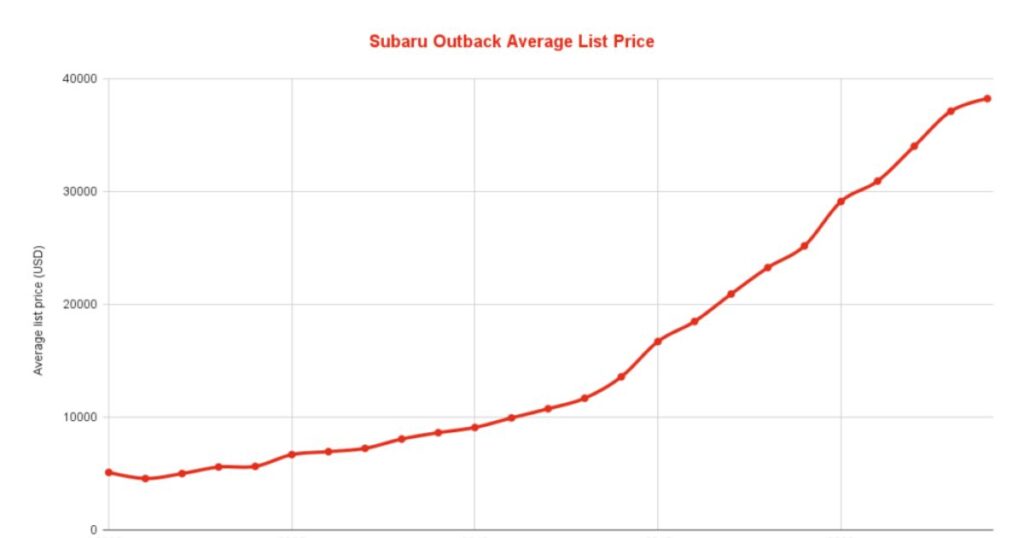
Choosing the Right Subaru Outback Model Year
As we wrap up our exploration of the Subaru Outback’s evolutionary journey, it’s crucial to weigh all factors when choosing the ideal model year for your needs. From reliability and performance to safety and comfort, each generation and model year offers its unique strengths and potential drawbacks.
Final Thought
When considering a pre-owned Subaru Outback, be sure to consult this comprehensive guide and cross-reference it with your specific requirements. Additionally, thorough vehicle inspections and maintenance history checks are recommended to ensure you make an informed decision.
From your experiences with the Subaru Outback, which year has stood out for you the most, and why? We’d love to hear your perspectives and insights in the comments below.

Hey there! I have 5 years of experienced repairing all makes and models. Specializes in engine diagnostics, brake repair, electrical systems, and teaching DIY maintenance tips. Passionate about keeping cars running safely.

